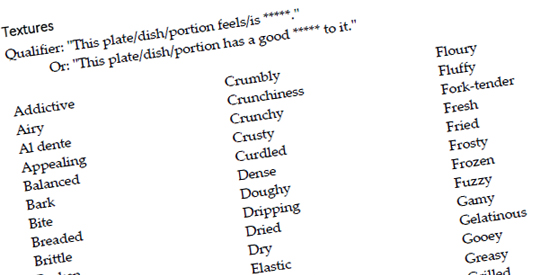
Click here to download the complete list of adjectives on our sister site, Cuisinology.com.
We eat regularly. Whether you’re a snacker who barely eats anything but small meals throughout the day, or a trucker or charter bus driver who eats big meals to endure the longer drives, or an athlete or a member of the military who eats larger and more specific meals to achieve various physical goals, food is a part of our everyday lives. We then go to eat at a restaurant, take a bite of food … and the server invariably appears just then to ask “How is everything?” After chewing that bite of food and finally swallowing, do you honestly know how discuss what you’re eating? If you’ve watched the countless competitions on various food channels you might have an inkling of what to say. But like anything else, it takes practice.
Consider the popular Chicken Pot Pie. There are variations that some might also mention, such as the salmon, lobster, and pork pies popular in New England, the Cornish pasty of Minnesota and the upper peninsula of Michigan, and other local specialty pies. Going with the basic version, a Chicken Pot Pie, be it from a Southern cook, a pie shop in Maine, or a Grandmother in the midwest, has some characteristics which you may expect but haven’t actively thought through. The crust can be a light and flaky butter crust such as the ones found in fruit dessert pies. The more common crust is a shortening crust, although lard is once again becoming popular. These crusts are more robust and dense than their flaky, buttery counterpart. In either case the baker needs to protect the edge of the crust to prevent excessive browning or singing during cooking as this makes the crust edge unpalatable. The sauce in the pie should be rich and thick, creamy and well-seasoned, with a robust chicken flavor. It shouldn’t be thin or watery, or be floury or starchy in flavor or texture. The vegetables should be firm and have a good bite to them, being well-seasoned and flavorful, certainly not soggy or bland. There should be ample chicken that’s well-seasoned, moist, fork-tender, and has a good bite to it, not soggy, bland or fatty whatsoever. Overall the pie should look appealing, have ample filling to be the robust comfort food the diner expects it to be.
In the above discussion there are certain adjectives used in describing the various parts of the dish:
- Chicken Pot Pie: Appealing, Ample, Robust, Comfort food
- Crust: Light or dense, Flaky or Robust, possibly Buttery, not Browned, Singed or Unpalatable
- Sauce: Rich, Thick, Creamy, Well-seasoned, Robust, not Thin, Watery, Floury or Starchy
- Vegetables: Firm, good Bite, Well-seasoned, Flavorful, not Soggy or Bland
- Chicken: Ample, Well-seasoned, Moist, Fork-tender, good Bite, not Soggy, Bland or Fatty
What diners expect to find in a good Chicken Pot Pie is now condensed into this relatively short list of adjectives, including both pros and cons. This becomes a method for determining if your own pies are acceptable, or if those made by others or served at restaurants you visit are acceptable. What’s right or wrong with a given pie can then be discussed and any adjustments can be made. The list can also be used to develop cards for judging Chicken Pot Pies at competitions. Learning to talk about food can be that versatile.
In menu descriptions the Chicken Pot Pie can be described in similar manners. But in menu descriptions there are rules that have to be followed:
- Simple: Ensure any diner can understand the menu description without much further explanation by the server.
- Accurate: Preparation methods, personnel quality certifications, and other descriptors have to match how the dish is made.
- Truthful: Point-of-origin or source, ingredient certifications, and related information cannot cause a “bait and switch” situation.
Menu descriptions for a Chicken Pot Pie might read as follows:
- “Chicken Pot Pie, a great comfort food.”
- This can be baked and served from whole, frozen pies without possible issues.
- “Handmade, just like Grandma used to make! Rich and creamy, with large chunks of chicken, lots of veggies, and a golden, flaky crust.”
- The pie crusts, chicken and vegetables might be from frozen and the sauce might be from a can, as that’s how Grandma might have made it. But the pie has to be assembled and baked in the restaurant’s kitchen or in a supplying commissary.
- “Our handmade pie, made with fresh hand-cut vegetables and whole chicken, and a thick flavorful sauce in a golden-brown crust.”
- Only the vegetables have to be fresh, the rest can be as in the first example, including the chicken being from frozen.
- “Handmade pie, made with tender, slow-roasted free-range local chicken, with organic vegetables cooked to perfection, a rich and creamy sauce made from whole local milk delivered daily, and our own robust and flavorful lard crust. Our most popular comfort food! Topped with a slice of our fresh, handmade mozzarella and additional sauce on request.”
- All of this has to be absolutely true for each and every pie. If, for example, local chicken isn’t available for some pies, or anything else in the description cannot be fulfilled, it’s better to 86 the pie off the menu until the described ingredient is once-again available than it is to possibly become embroiled in claims or court judgements of false advertising.